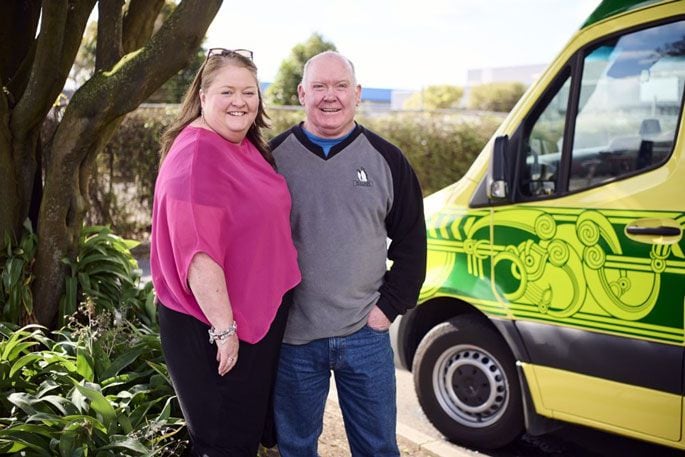October is now dubbed Shocktober for the third year running and Hato Hone St John is on a mission to empower as many people as possible with lifesaving skills as part of its Cardiopulmonary Resuscitation awareness month.
This October we’ve dedicated the entire month to educate as many Kiwis as possible across the motu how to respond to someone having a cardiac arrest.
Jacci Tatnell, HHStJ national manager – community education, said Aotearoa has some of the worst cardiac arrest survival rates in the world and HHStJ wants to turn that around by enabling New Zealanders to learn its 3 Steps for Life skills to save lives.
“Knowing what to do in these situations is a necessity, especially when you consider our grim statistics. In New Zealand, seven people every day will have an out of hospital cardiac arrest with only 11% surviving,” she said.
Mark, whose last name has not been used for privacy reasons, was one of the lucky ones. He is alive and spending Christmas with his loved ones because the 3 Steps for Life were taken when it counted.
When ambulance officers arrived at Mark’s home in May 2023, they knew straight away his life was in danger.
He was rushed to hospital under lights and sirens. Within minutes of arrival, his heart suddenly stopped beating. For a few terrifying moments, Mark lay unconscious, his life hanging in the balance.
Earlier that evening Mark hadn’t been too worried when his chest first felt tight. As a lifelong asthmatic, a bit of difficulty breathing wasn’t that unusual. But it didn’t go away. Luckily, his wife Julie-Anne called 111.
When paramedics arrived, the ECG (Electrocardiogram) showed Mark was having a STEMI (ST-Elevation Myocardial Infarction) – the most dangerous type of heart attack. He was loaded into the ambulance and the journey to hospital began.
However, as the crew were handing him over to the cardiologist at the hospital, things took a sudden turn for the worst. His heart rate went from a normal rhythm to ventricular tachycardia - his heart stopped.
Thankfully, the team attached and charged the defibrillator that shocked his heart back into normal rhythm. Mark remembers it felt like falling asleep.
“I started to drift off. When I woke up, I said to my wife, ‘Oh sorry honey, I didn’t mean to fall asleep on you.’ That’s when she told me I’d actually died.”
A week later, Mark was back at home, his blocked arteries now cleared. But it could have gone very differently.
Without his wife calling 111, and the quick response of a nearby ambulance, Mark might have still been at home when his heart stopped beating.
Mark is happy to share his story so more everyday Kiwis are equipped with the skills and knowledge to perform the 3 Steps for Life.
“During Shocktober HHStJ will be teaching as many Kiwis as possible the 3 Steps for Life to empower them with the knowledge and confidence to act quickly in an emergency. They are simple to learn - Step one: Call 111; Step two: Start CPR; Step three: Use an Automated External Defribrillator (AED). Our sessions teach everyone how to perform CPR and use an AED,” says Jacci Tatnell.
“Cardiac arrest is still one of Aotearoa’s biggest killers. Survival chances dramatically improve the sooner CPR begins, and we want everyone to have the confidence to perform the three steps that can double a person’s chance of surviving,”
“We’re calling for people to go along to the free 3 Steps for Life CPR training sessions in their community.”
Click here to find the locations of where these are taking place.
Hato Hone St John also encourages people to download the CPR app or join a network of volunteers by registering on the GoodSAM* app to help those suffering a cardiac arrest – because every second counts.
Join Hato Hone St John this Shocktober and begin the journey to become a nation of lifesavers.
The Statistics:
- Seven people a day are treated for an out-of-hospital cardiac arrest in New Zealand (more than 2000 per year) 32% female, 68% male.
- 76% of patients receive bystander CPR.
- 6% receive defibrillation by a community responder prior to ambulance arrival.
- 23% of patients survive the event (have a pulse on arrival at hospital).
- 11% of patients survive.
- New Zealand has more than 12,800 people registered as GoodSAM* responders
- AED numbers in the community are growing, with more than 13,660 registered throughout the country. That number has been bolstered at marae across New Zealand with gifts of AEDs into vulnerable communities thanks to ASB, with the support of Phillips and Hato Hone St John. In addition, all ASB branches have AEDs.
Find more information in the Out of Hospital Cardiac Arrest report here.
How you can help:
- Visit the *GoodSAM website to register as a responder or download the GoodSAM app from the app store. The GoodSAM network of trained volunteers - including doctors, nurses, paramedics and registered first aiders - give life support to people in cardiac arrest while help is on the way. GoodSAM is a free app that alerts trained volunteers that a person nearby could be in cardiac arrest, allowing them to provide basic life support and first aid before emergency services arriving.
- Download the Hato Hone St John CPR app. This gives you instructions on how to perform CPR and use an AED (including videos), a timer to help with steady chest compressions and is available.
- Download the AED Locations app to find the nearest AED in your area.
- Find Shocktober training session locations, dates and times here.



1 comment
Elephant in the room
Posted on 01-10-2024 14:07 | By Saul
Heart issues have been rising massively the last few years... Wonder what's causing it?
Leave a Comment
You must be logged in to make a comment.